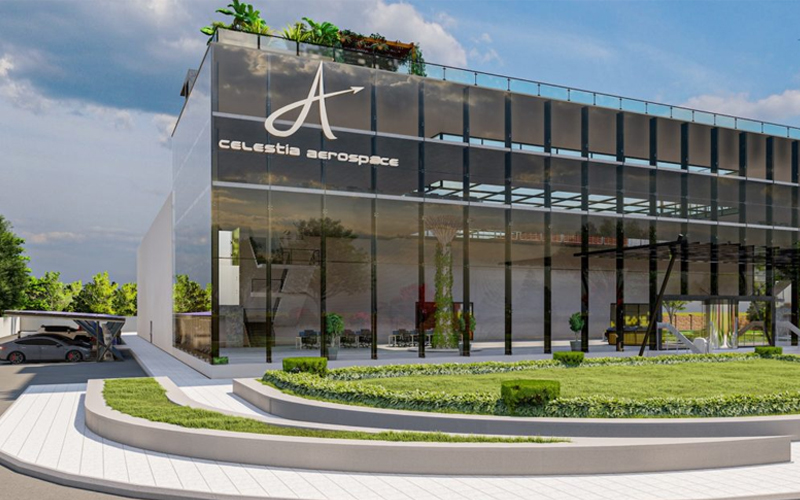
Spanish launch and nanosatellite manufacturing startup Celestia Aerospace announced yesterday that it had entered into an agreement with the City of Sabadell and Consorci de la Zona Franca to establish its HQ and nanosatellite production plant in Sabadell, Spain.
The facility will, apparently, be over 6000 square metres and will be ready by 2025. It will host offices, a mission control centre, a development centre, a nanosatellite construction chain, and a Space Arrow development area. Space Arrow is the company’s proposed launch system that will utilize a MiG-29UB to launch rockets to orbit carrying no more than 16 kg payloads at a time.
According to reports, the Consorcio de la Zona Franca de Barcelona (Barcelona Free Zone Consortium) bought the plot of land in the Sant Pau de Riu Sec industrial estate, owned by the Sabadell City Council, for the new facility to be built on. The project is part of a continued effort to promote the Aeronautical Innovation Hub.
This all comes about a year after the company announced the closure of a staggeringly large €100 million seed round. The entire round was supplied by a single investor, the London-based Invema LTD.
Now for the weird
Nothing about this company makes sense. Despite it being over a year since the closure of that colossal seed round, Celestia is, according to the company’s LinkedIn page, still just two people, the company’s founders Gloria Garcia-Cuadrado and Daniel Ventura González Alonso.
The company also doesn’t seem to have filed any financials since 2018 and has made no apparent development progress on Space Arrow despite the company having been founded in 2014.
The two Celestia founders also split their time with another company they cofounded, some kind media company called Estudio Brainstorm. Estudio Brainstorm was founded in 1999 and appears to be the healthier of the pair’s two endeavors having filed financials for the company through to 2020.
According to an Invema presentation outlining the development of the “full cycle nanosat” services, the team working on it is, in addition to the founders, made up of Robert Lainé, Adriano Camps, Ángel Mateo, and Fatmah Baothman. All four are listed as senior advisors. The thing is, of the three that have public LinkedIn profiles, not a single one lists Celestia or Invema as present or past employers. Baothman does, however, have an even more confusing connection to the whole thing.
Who is Invema?
Then there’s Invema, the company’s mysterious benefactor. The company describes itself as a “financial advice, strategic solutions, and consulting” business. According to company filings, Fatmah Baothman owns 25% of the company’s voting rights while Jorge Martinez Montferrer owns the remaining 75%. The company’s most recent financial filings appear to indicate assets worth nearly five billion pounds.
Despite having a 25% stake in a five-billion-pound company, Fatmah Baothman lists her occupation on LinkedIn as an Associate Professor at King AbdulAziz University in Saudi Arabia.
Jorge Martinez Montferrer is mostly a ghost. The man is referenced widely as being associated with Invema but appears to have no public profiles and even the Invema website does not feature a picture.
The financial history of the company is also fascinating. According to public filings, the company had total assets of £21,465 in 2015. So, how did this small company transform into the five-billion-pound company it is today? Well, in November 2016 the company filed a statement of capital following an allotment of shares with a total aggregate nominal value of €5.7 billion.
Following that announcement, the company’s filing for the year ending 30 November 2016 stated that it had total assets of £4.577 billion. Interestingly, in this filing, the company lists its 2015 assets as being £1.233 billion pounds instead of just £21,465. I am not sure what accounts for that discrepancy.
For the year ending 30 November 2017, the company had total assets of £4.582 billion. In 2018, it had £4.578 billion in assets. 2019 is £4.577 billion. In 2020, it’s £4.986 billion with 2019 now showing assets totaling £4.986 billion. The most recent filing for the year ending November 2021 has the company with £4.986 billion in total assets. It’s also interesting to note that the financial statements in question are short and never more than 10 pages, which, in my experience, is uncommon for billion-pound companies.
Then we have its deals. Acquiring banks in Tunisia, a collaboration with SAD Africa International (which doesn’t seem to exist outside two pastors in the Congo) to construct schools and adult health centres, and the financing of the Centro Médico Esmeralda in Mexico. That last one does appear to exist but not in anywhere near the form that Invema presented.
Conclusions
Nothing about this story makes sense. However, I also can’t deny that the money appears to be there. I would assume that with a company filing £4.5 billion in assets, UK government officials must surely have verified that those funds do, in fact, exist if nothing else to ensure that it is taxed correctly. It also does appear to have been some kind of agreement for the new nanosatellite facility if the reports are to be believed.
I also do seem to be alone in my suspicions. Forbes.es reported the news of the new nanosatellite uncritically as did La Información and El Periódico, three seemingly respected news outlets each with that coveted golden check mark on Twitter. They also all referenced the €100 million seed round seemingly not thinking that it was strange that a two-person company had managed to attract that kind of investment. Can I really be the only one who thinks there’s something not quite right here?

